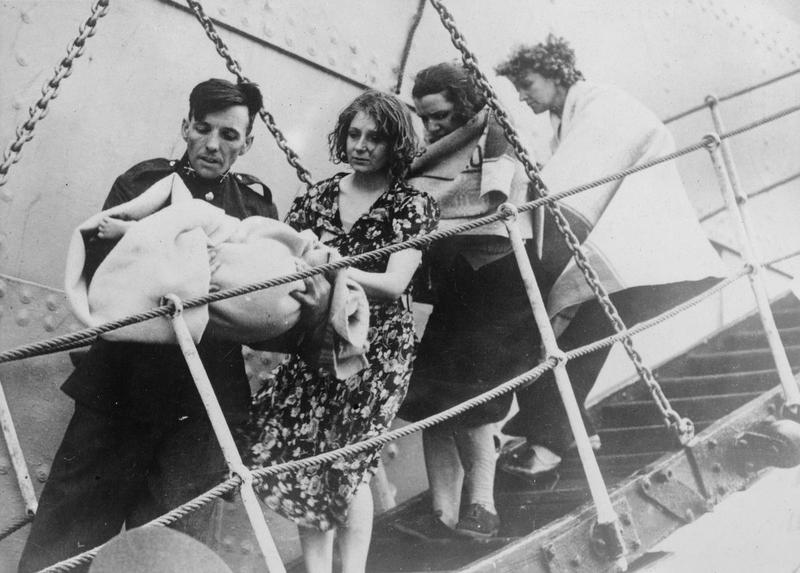Britain's Royal Navy
The War Illustrated, Volume 1, No. 1, Page 16-17, September 16, 1939.
"The royal navy of England," wrote Sir William Blackstone, "has ever been its greatest defence and ornament ; it is its ancient and natural strength ; the floating bulwark of the island." The statement made with such careful precision in the spacious days of George III might be repeated without a change in phrase or word today when George VI is king. Still the Royal Navy is the "floating bulwark" of Britain and Britain’s friends.
What is the world’s most formidable fleet – the Imperial British Navy – is depicted in most striking fashion in this panorama specially drawn for "The Daily Telegraph" by Dr. Oscar Parkes, the naval artist, and reproduced here through the courtesy of that newspaper. Most of the vessels depicted have already taken their place in the fighting line on the seven seas, and the remainder are approaching completion.
It should be noted that the illustration does not include any vessels of the 1939 construction programme, which comprises two 40,000-ton battleships of the Lion class, four 8,000-ton cruisers of the Fiji class, one large aircraft-carrier, sixteen destroyers, four submarines, twenty-two escort vessels, and a number of auxiliary craft. Furthermore, it need hardly be said that it exhibits no details of any new ships which have not been published, and in some cases, such as the Lion class of battleships, the illustrations have no more than a token significance.
Proceeding now to a summary of the ships shown in the panorama, on the horizon are 171 destroyers ; Iron Duke, Jellicoe’s flagship at the battle of Jutland (shown in the middle above the top line of ships in the left-hand section of the drawing), and depot ships.
A – 51 minesweepers and patrol vessels. B – 39 escort vessels and two netlayers, Guardian (25) and Protector (26).
Next (C, D, E, F) ride serried columns of cruisers ranging from a few survivors of the Great War, of 1914-1918 programme, to the very latest types, e.g. the 10,000-ton Belfast and Edinburgh, the 9,100-ton Southampton class, the 8,000-ton Fijis (which, despite very moderate size, mount twelve 6-in. guns), and the small but exceptionally powerful cruisers of the Dido group. On these cruisers largely depends the responsibility of ensuring the safety of our trade routes in war-time.
The cruisers in line C are – 1, Despatch; 2, Diomede; 3, Delhi; 4, Dunedin; 5, Durban; 6, Danae; 7, Dauntless; 8, Dragon; 9, Enterprise; 10, Emerald; 11, Adventure (minelayer); 12, Cardiff; 13, Calcutta; 14, Carlisle; 15, Capetown; 16, Curlew; 17, Coventry; 18, Cairo; 19, Curacoa; 20, Colombo; 21, Ceres; 22, Caradoc; 23, Calypso; 24, Caledon.
In line D all the cruisers are building excepting Edinburgh, Belfast and Adelaide.
The next line, G, comprises battleships and carriers (all building). Two new battleships of the Lion class, each of 40,000 tons (to be armed with 16-in guns); these were recently laid down; the five almost equally powerful ships of the King George V type (35,000 tons, ten 14-in. guns), launched this year ; and the huge 23,000 tons group of aircraft-carriers known as the Illustrious class – Illustrious, Victorious, Formidable, Indomitable and Implacable – each capable of taking to sea between sixty and seventy aircraft.
H – In this line are the five Queen Elizabeth battleships which have been practically rebuilt: Warspite, Malaya, Barham, Valiant and Queen Elizabeth; the aircraft-carriers Ark Royal, Furious, Courageous, Glorious, Eagle, and other smaller vessels of the same type.
I – Here will be observed the outlines of the battleships Nelson and Rodney, the five sister ships of the Royal Sovereign class: Royal Sovereign, Royal Oak, Revenge, Resolution, and Ramillies – with the battle-cruiser Hood (still the world’s largest man-of-war, 42,100 tons), and her modernized consorts Repulse and Renown, and submarines and monitors.
J – Patrol vessels, destroyers, escort vessels and gunboats.
K – Escort vessels, minesweepers and minelayers.
The personnel of this mighty force reaches an establishment of about 135,000, a figure unmatched by any other navy in the world, and it may be said in every confidence that, though our ships are no longer "hearts of oak," still today, as in all the centuries of the past, "hearts of oak are our men."
Index
Previous article
The Dastardly Sinking of the 'Athenia'
Hardly had the world realized that war had again begun when it received with a thrill of horror the news that the German U-boats had claimed their first victim. Without a word of warning, a passenger
Next article
Danzig and the Men Who Betrayed It
Situated at the mouth of the Vistula, great river of Eastern Europe, stands Danzig, the city which was the final objective in Hitler’s campaign of aggression. For centuries it has been a centre of e




